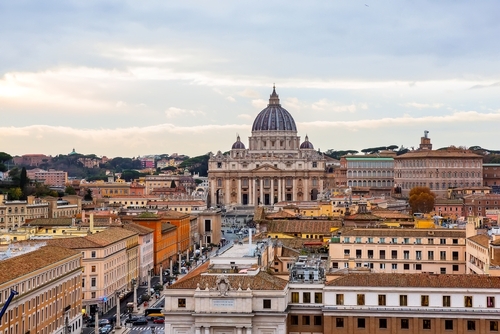When you think of countries, sprawling lands, millions of people, and buzzing cities may come to mind. But what if I told you that the smallest country in the world is no bigger than a small neighborhood in a big city? Intriguing, right? Let’s take a deeper look at an incredible microstate that holds the title of “smallest country in the world.”
The Smallest Country in the World is… Vatican City!
By both area and population, Vatican City holds the rightful claim as the world’s smallest country. Nestled within the heart of Rome, Italy, Vatican City spans just 0.2 square miles (0.49 square kilometers). To put that into perspective, the entire country is smaller than New York’s Central Park.
This city-state is also the beating heart of the Roman Catholic Church and the official residence of the Pope. Despite its tiny size, Vatican City is monumental in cultural, spiritual, and political significance, attracting millions of visitors each year.
What Makes Vatican City a Country?
You might be wondering, how can a place so small be classified as an independent country? Here’s what defines Vatican City as a sovereign state:
- Independence: Vatican City became an independent state on February 11, 1929, after the signing of the Lateran Treaty between the Holy See (the governing body of the Church) and Italy.
- Government: Vatican City operates as an ecclesiastical state governed by the Pope, who has legislative, executive, and judicial powers.
- Borders and Population: Though entirely surrounded by Rome, Vatican City has well-defined borders. Its population fluctuates around 800 to 1,000 residents, primarily clergy, Swiss Guards, and laypeople who work within the city.
A Closer Look at Life in the World’s Smallest Country
Despite its size, Vatican City is much more than a tiny territory. Here are some highlights of what makes it special:
1. The Vatican Museums
Home to some of the most treasured art and artifacts in history, the Vatican Museums display works from Michelangelo, Raphael, and other renowned artists. The Sistine Chapel, with its breathtaking ceiling painted by Michelangelo, draws thousands of visitors daily.
2. St. Peter’s Basilica
The centerpiece of Vatican City, St. Peter’s Basilica is an architectural marvel and one of the holiest places in Christianity. It’s the site of significant events like papal ceremonies and celebrations, as well as housing Michelangelo’s famous sculpture, Pietà.
3. Swiss Guards
The Vatican is protected by one of the world’s oldest and most colorful military units, the Pontifical Swiss Guard. While their medieval-style uniforms may seem ceremonial, they play a crucial role in ensuring the Pope’s safety.
4. Vatican Residents and Limited Citizenship
While Vatican City is home to under 1,000 residents, citizenship is granted only to those who work closely with the Holy See, such as cardinals, priests, and the Swiss Guard. Citizenship is temporary, ending when their term of service concludes.

Why Does Vatican City Matter?
While its size makes it unique, Vatican City’s importance extends far beyond its borders. Here’s why it’s globally significant:
- Spiritual Influence: Vatican City is the spiritual hub for more than 1.2 billion Catholics around the world. It serves as a center for religious events, theological discussions, and pilgrimages.
- Cultural Treasures: From the Sistine Chapel to ancient manuscripts preserved in the Vatican Apostolic Library, the city houses countless cultural and historical artifacts.
- Diplomatic Roles: Despite its small population, Vatican City maintains diplomatic relationships with almost every country, acting as a key voice in global matters.
Other Small Countries That Might Surprise You
While Vatican City takes the lead, there are other tiny nations that pack a cultural or historical punch:
- Monaco – An independent city-state on the French Riviera, famous for its casinos and Grand Prix, spanning just 0.78 square miles.
- Nauru – The smallest island country in the Pacific Ocean, covering only 8.1 square miles.
- San Marino – A landlocked nation in Italy, renowned as the world’s oldest republic, with an area of 24 square miles.
These microstates may not claim vast territories, but they shine brightly with unique identities and rich histories.
FAQs About the World’s Smallest Country
What is the world’s smallest country by population?
Vatican City is also the smallest country in terms of population, with an estimated 800 to 1,000 residents.
Can I visit Vatican City?
Yes! Vatican City is one of the most visited tourist destinations in the world. You can explore iconic sites like St. Peter’s Basilica, the Vatican Gardens, and the Vatican Museums.
Is Vatican City completely independent from Italy?
Yes, while it is located entirely within the city of Rome, Italy, Vatican City operates independently with its own government, laws, and even its own postal system.
What Does the Smallest Country in the World Contribute to the Russian-Speaking World?
Exploring the landscape of russianspeaking nations reveals that the smallest country in the world, Vatican City, plays a unique role. While often overlooked, its cultural and religious influence reaches far and wide, fostering dialogue and unity among communities. This spiritual connection highlights the diverse tapestry of the Russian-speaking experience.
Exploring the World’s Micro Marvel
Despite its modest size, Vatican City proves that a nation’s importance isn’t measured in square miles. It represents immense spiritual, cultural, and historical significance that resonates far beyond its physical borders.
Want to learn more exciting facts about the world? Be sure to explore our other blogs for fascinating insights and guides!
